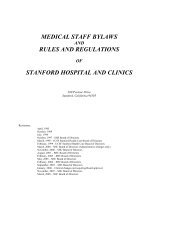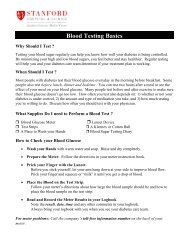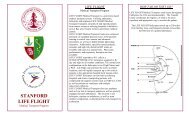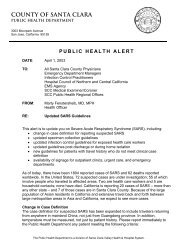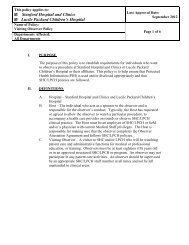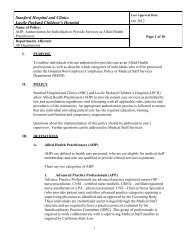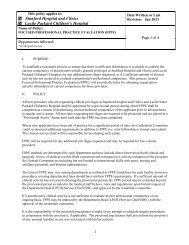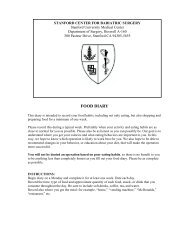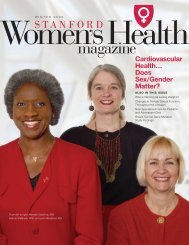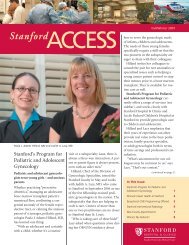rEdEFInIng - Stanford Hospital & Clinics
rEdEFInIng - Stanford Hospital & Clinics
rEdEFInIng - Stanford Hospital & Clinics
Create successful ePaper yourself
Turn your PDF publications into a flip-book with our unique Google optimized e-Paper software.
GENERAL SURGERY<br />
ExPERIENCE THAT mAkES THE dIffERENCE<br />
In the emergency room, patients’ chances of survival come down to the<br />
extent of their injuries, the timeliness of their treatment and the degree of<br />
technical expertise their trauma surgeon brings. <strong>Stanford</strong> <strong>Hospital</strong> is the<br />
only level 1 Trauma Center between San Francisco and San Jose—and<br />
one of the few in the country to receive a flawless report from the American<br />
College of Surgeons’ Committee on Trauma. Patients taken to a trauma<br />
center after serious injury have a 20–25 percent greater chance of survival,<br />
and for more than 40 years, the ED at <strong>Stanford</strong> <strong>Hospital</strong> has served all<br />
South Peninsula residents.<br />
12<br />
WITH MORE THAN 50,000 VISITS EACH YEAR, THE<br />
STANFORD HOSPITAl EMERgENCY DEPARTMENT’S<br />
PATIENT ADMITTINg REPRESENTATIVES, uNIT<br />
SECRETARIES AND VOluNTEERS ARE AlWAYS<br />
ON HAND TO MEET THE COMMuNITY’S NEEDS.<br />
Return to TOC<br />
steady hands<br />
WHEn<br />
minute<br />
EvErY<br />
cOUnTs<br />
“You have to be calm and level-headed in<br />
what by nature is chaos, and time is never<br />
on our side.”<br />
Dr. Rachael Callcut<br />
Surgeon<br />
Trauma/Critical Care<br />
What is it like to work as a general surgeon in the Emergency<br />
Department? “You have to be calm and level-headed in what<br />
by nature is chaos, and time is never on our side,” answers<br />
Dr. Rachael Callcut, trauma surgeon at <strong>Stanford</strong> <strong>Hospital</strong> &<br />
<strong>Clinics</strong>. Jose Hernandez learned just how important taming<br />
that chaos is when he was rushed to <strong>Stanford</strong> <strong>Hospital</strong>’s<br />
Emergency Department after a head-on collision on the<br />
Dumbarton Bridge.<br />
Though the healthy 22-year-old never lost consciousness,<br />
Dr. Callcut knew he was in serious danger. His vital signs<br />
were initially not out of the ordinary, but his complaints<br />
of abdominal pain and his pallor suggested that he was<br />
bleeding. As soon as Dr. Callcut moved the wand of a<br />
portable ultrasound across his body, she could pinpoint<br />
the problem—about a third of Jose’s blood had poured<br />
out into his abdomen.<br />
“Time was running out quickly,” says Dr. Callcut. “In another<br />
15 minutes, Jose would have bled to death.” Within five<br />
minutes of arriving at the hospital, Jose was on his way to<br />
surgery, where Dr. Callcut and others quickly sewed up<br />
his most crucial wounds, keeping Jose alive long enough<br />
to treat his less serious injuries.<br />
When Jose came to several days after his surgeries, he took<br />
stock of his life. “laying in bed there,” he says, “I started<br />
appreciating what had happened to me, and believing that<br />
god exists.” Jose has since made a full recovery, and enjoys<br />
spending time with his wife and baby daughter.<br />
13




